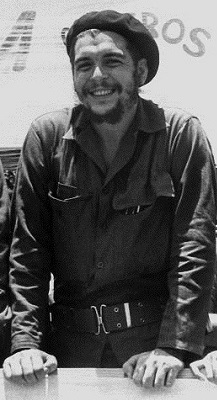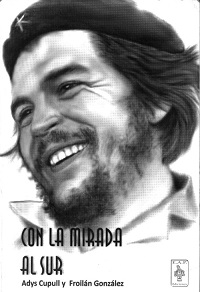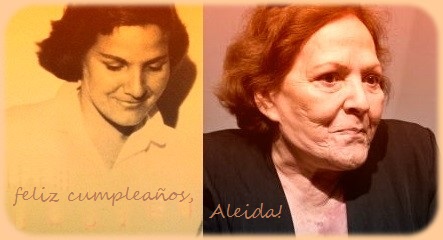|
~ Ernesto Che Guevara
~ Galéria
~ Oldal
~ Bejelentkezés
~ Vissza a Főoldalra
Ernesto Che Guevara, az argentin származású forradalmár, miniszter, gerillavezér és író, Buenos Aires-ben szerzett orvosi diplomát, majd a kubai forradalom során jelentős szerepet játszott a szigetország felszabadításában és újjáépítésében. A kubai gazdaság talpraállításáért dolgozott, küzdött az oktatás és az egészségügy fejlesztéséért, az írástudatlanság és a faji előítéletek felszámolásáért. Saját példájával népszerűsítette az önkéntes munkát. Kongóban és Bolíviában is harcolt - harminckilenc éves volt, amikor az amerikai-bolíviai csapatok csapdába ejtették és kivégezték.
| | |
|

| | |
|
|
|
Aleida Guevara presents the No 39 Honda Magazine dedicated to Che
|
|
|
The Honda magazine, published by Sociedad Cultural José Martí and founded in 2000, dedicated their number 39 to honour José Martí and Che Guevara. The new issue was presented by Aleida Guevara March in Sala Caturla de la Biblioteca Provincial, who also talked about the different articles - especially the speech that her father made on 28th January 1960 on commemorating the birth of José Martí.
One of the most interesting articles from the magazine is The revolutionary essence of Che's thoughts, written by Armando Hart Dávalos, in which the author shared the letter that Che sent him in 1965. The letter shows Che's sincerity with which he criticized the Soviet cadres who at that era hindered the proper development of the socialism in Cuba.
Aleida confirmed: "We have become accustomed to criticize everything, but [only] a few of us are able to provide solutions to these criticisms.This article shows exactly those solutions that my father offered. The students will really enjoy it because it says what we need to do in order to get a better approach to the study of Marxism in our schools. Che said that we have to be profound but never lose the joy."
Among others, such articles can be read in the issue like that of María del Carmen García Ariet, the coordinator of the Che Guevara Studies Center (Centro de Estudios Che Guevara), and The Importance of Being Ernesto, written by the Guatemalan author, Marco Vinicio Mejia.
Aleida Guevara was happy to be chosen to present this issue of the magazine. During her speech, she quoted Ricardo Alarcón who wrote at the end of his essay that there is no better educator than Ernesto Guevara - it pleased her even more.
"What Martí dreamt about - my father made it come true. Sometimes we ourselves become bad examples for the young people. To be able to train someone, first you have to demonstrate it with your own life. [...] The best way to commemorate the 85th anniversary of his [Che's] birth is actually to do what he taught us, by putting it into practice... Our duty is to finish what he could not. "
When she was asked about the characteristics of her father, Aleida said: "I had the privilege of having a mother who loved my father extraordinarily and she passed that love to us. It is not just a love of words, it is a love of deeds. She taught us to honour him by becoming good revolutionaries. She always said that he didn't want his children to be special personalities and exclusive men and women of this nation. At the same time, we lived with a lot of dignity, discipline and freedom."
Rafael Polanco Brahojos, the director of the magazine explained: "We have prepared for this edition. We've always wanted to dedicate the magazine to prominent figures of important dates, through Martí's ideas. For example, to the figures of Cuban and universal culture, those about whom Martí spoke in his writings, for instance Richard Wargner or Giuseppe Verdi. We have always been impressed how much culture he collected and shared. Today we are pleased to come to Santa Clara to present this issue."
Source
|
|
|


| 2014.02.20. 00:00, Aleida |
Che Guevara visiting Sri Lanka
|
Ötven évvel azután, hogy az argentín forradalmár, Ernesto “Che” Guevara látogatást tett Sri Lanka-n (Ceylon), az általa ültetett mahagónifa még mindig áll.
1959. augusztus 7-én, az ázsiai körútjának részeként Che látogatást tett a Yahala Kele gumifa-ültetvényen Horana-ban, hogy tanulmányozza a gumifa-ültetési módszereket a rövid sri lankai tartózkodása alatt és ő maga is ültetett egy mahagónifát. A nevezetes napra még mindig jól emlékszik Dingiri Mahattaya, az ültetvény gondozója, akit az a szerencse ért, hogy találkozhatott a neves forradalmárral.
Dingiri Mahattaya 1944-ben tizenöt évesen került az ültetvényre, ahol azóta is dolgozik és ahol számos híresség tette már tiszteletét.
Che látogatásánák emlékét néhány bekeretezett fénykép és az általa ültetett fenséges fa őrzi - ez utóbbi előtt egy kőtábla áll, rajta Che neve és az ültetás dátuma.
Dingiri Mahattya aznap reggel csak annyit tudott, hogy egy fontos személyiség érkezik majd, hogy szétnézzen az ültetvényen és akkor nem is ismerte fel, hogy az egyik látogatója maga Ernesto “Che’ Guevara volt. Mégis emlékszik a magas, szakállas férfira, aki katonai egyenuhát viselt és szivarozott, három másik idegen társaságában. Che néhány órát töltött ott, körbesétálta az ültetvényt és indulás előtt megreggelizett. Távozáskor egy doboz szivarral ajándékozta meg Dingiriya Mahattaya-t.
Dingiri Mahattaya elmondta, hogy a mahagónifa az egyetlen az egész világon, ami életben maradt azok közül, amiket Che valaha ültetett. A fenséges megjelenésű fa remekül szimbolizálja azt az embert, aki a halála után négy évtizeddel is képes milliók képzeletét megragadni szerte a világon.
Forrás
Néhány fotót is megtekinthettek Che látogatásáról:
~ 1959. augusztus 7. Sri Lanka [×04]
|
|
A larger than life tree for larger than life man
Dingiri Mahattaya, the caretaker of Yahala Kele estate recalls one of his greatest moments - when Che Guevara came visiting. Pix by M.A.Pushpakumara
Fifty years after Argentinean revolutionary Ernesto “Che” Guevara visited Sri Lanka, the Mahogany tree that he planted still stands tall.
Che visited the Yahala Kele rubber estate in Horana to study rubber planting methods during his brief stay in the country and planted the Mahogany tree on August 7, 1959. Che’s visit to the estate is still clear in the mind of one man who had the good fortune to meet the great revolutionary leader. For Dingiri Mahattaya, the caretaker of the estate and bungalow at Yahala Kele, the memories of the day are well etched in his mind.
Dingiri Mahattaya who is nearing 80 came to work at the bungalow in 1944 when he was just 15 years of age. More than 60 years later he is still there and though the glory of his early years at the estate have faded away, he takes great pride in recollecting the good, old days on the estate. The estate belonging to J.C.D. Peries was more than 1500 acres in extent, and in its sprawling expanse were summer huts, a swimming pool, ponds and fountains making it an idyllic setting to entertain important visitors. A host of Sri Lankan leaders including Prime Ministers Dudley Senanayake, Mrs. Sirimavo Bandaranaike and President J.R.Jayawardene were among those who visited the estate. But despite the visits by presidents, prime ministers and other dignitaries it is Che’s visit that has become symbolic of this estate.
Today what bears testimony to the historic visit are the framed photographs hanging inside the bungalow, the majestic Mahogany tree planted by Che and the fast fading stone slab recording the name and date of the person who planted the tiny sapling that day in August fifty years ago.
Dingiri Mahattya had no idea about the identity of the visitors who were to arrive at the estate that morning even though he had been informed the previous evening that an important person would be among the group visiting the estate and asked to prepare breakfast for them. When the visitors arrived, Dingiri Mahattaya did not know that among them was Ernesto “Che’ Guevara, till after they had left. But he recalls that the tall bearded man, clad in military fatigues with cigar in hand stood out in the group which also included three other foreigners. Che had spent several hours walking round the estate and had breakfast before leaving. Dingiriya Mahattaya was presented a box of cigars before he left.
Che was visiting to study rubber planting techniques in Ceylon (Sri Lanka) as part of an Asian tour which also took him to India and several other countries in the region. Sri Lanka is one of the few countries he visited in his lifetime. Standing under the mahogany tree, Dingiri Mahattaya says, “I was told that this is the only surviving tree in the world that has been planted by Che Guevara.”
That is something hard to verify but the majestic appearance of the tree indeed makes it a fitting symbol for a man who continues to hold the imagination of millions of people across the world nearly four decades after his demise.
Source
You can check out a few photographs about Che's visit:
~ 7 August 1959, Sri Lanka [×04]
|
|
|


| 2014.02.19. 00:00, Aleida |
New books about Che Guevara
|
 Santa Clara-ban új könyveket mutatnak be Che Guevara-ról Santa Clara-ban új könyveket mutatnak be Che Guevara-ról
Ebben a városban mutatta be a két kubai kutató, Adys Cupull és Froilán González a könyveit, a 'Con la mirada al sur'-t, ami a hősies gerilla életének első huszonöt évéről szól, és a 'Revelaciones: El asesinato del Che en Bolivia'-t (Felfedezések: Che meggyilkolása Bolíviában). A könyvek bemutatójára vasárnap került sor a Plaza Comandante Ernesto Che Guevara-n, ahol elmondták, hogy az első szöveg az Ernestito vivo y presente című könyv bolíviai kiadása volt, amit számos latin-amerikai országban kiadtak, köztük Argentínában a hősies gerilla nyolcvanadik születésnapjának alkalmából.
A Revelaciones: El asesinato del Che en Bolivia egy vallomás- és információforrás-gyűjtemény, amit korábban még nem adtak ki. Ebből a könyvből az is kiderül, ki és milyen körülmények között segítette a szerzőket információval, és hogyan kutatták át a bolíviai belügy- és külügyminisztérium archívumát.
Két dokumentumfilm is bemutatásra került - a La muerte no es verdad egy nyolcperces film az 1967. október 9-én Bolíviában eltöltött bűntettekről, a másik film pedig egy húszrészes, a bolíviai televízió számára készített sorozat, amely a bolíviai hadjáratban Che-hez csatlakozott harcosok életét mutatja be.
Forrás
|
|
New books about Che Guevara presented in Santa Clara
In this city the Cuban researchers Adys Cupull and Froilán González presented the books 'Con la mirada al sur', that is about the first twenty-five years of the heroic guerrilla's life, and 'Revelaciones: El asesinato del Che en Bolivia' (Revelations: The assassination of Che in Bolivia) . The launch of the books took place this Sunday at la Plaza Comandante Ernesto Che Guevara, where it was explained that the first text is the result of the Bolivian edition of the book Ernestito vivo y presente, that was published in many Latin-American countries, for example in Argentina for the 80th birthday of the Heroic Guerrilla.
Revelaciones: El asesinato del Che en Bolivia is a compilation of testimonies and sources of information that has never been published before. In this book it is also told who gave information, who helped the researchers and in what kind of circumstances, and how the archives of the Bolivian Inner Ministry and Foreign Affairs were searched.
Two documentaries were also presented - La muerte no es verdad is a 8-minute film about the crimes committed in Bolivia on 9th October 1967, while the other film is a 20-chapter series, made for the Bolivian television, about the lives of the combatants who joined Che in his Bolivian campaign.
Source
|
|
|


| 2014.02.18. 09:00, Aleida |
Feliz cumpleaños, Aleida!
|

Ma ünnepli Aleida March (Che Guevara második felesége és nagy szerelme, valamint a kubai forradalom egyik harcosa) a nyolcvanadik születésnapját! Feliz cumpleaños, Aleida!
|
|
Today Aleida March (Che Guevara's second wife and big love, a fighter at the Cuban Revolutionary War) is celebrating her eightieth birthday! Feliz cumpleaños, Aleida!
|
|
|
| 2014.02.18. 00:00, Aleida |
Poems Guevara lived and died by
|
Versek, amikért Guevara élt és halt
A zöld, szamárfüles jegyzetfüzet tartalmát, amit a forradalmár Che Guevara magával hordott, amikor 40 évvel ezelőtt [a cikk 2007 szeptemberében jelent meg] a CIA egy távoli bolíviai faluban lelőtte, most először bemutatták a lelkes rajongók előtt.
Nem politikai írások vagy katonai tervek, hanem egy gyűjtemény a kedvenc verseiből, amiket a saját kezével másolt le.
Előző nap Guevara-t választották 'Argentína legnagyobb történelmi és politikai alakjának', egy hónappal a halálának évfordulója előtt, egy mexikói kiadó megjelentetett egy könyvet, ami az antológiájának tartalmát tartalmazta. 'Amikor Che-t elkapták, a katonaság átkutatta a hátizsákját, és két jegyzetfüzetet találtak: az egyik a titkos kódokat tartalmazta, amelyek segítségével Havannával tartotta a kapcsolatot, és a zöld füzetet,' mondja a mexikói író és Guevara életrajzírója, Paco Ignacio, aki megírta a könyv előszavát.
Kollégák szerint Che az olcsó jegyzetfüzetet egy tanzániai útján vette 1963-ban és gyakran egy fa tetején ülve írt bele. A Planeta kiadó nem hajlandó elárulni, hogyan tettek szert a füzetre, de elmondták, hogy két évet töltöttek azzal, hogy bizonyosságot nyerjenek a hitelességéről.
'Nagyon bizalmas válogatás, politikai tartalmú versekkel és érzelmekről szóló költeményekkel. Ez új oldalát mutatja meg Che mítoszának,' mondja Ignacio.
A 69 vers némelyikét a chilei költő, Pablo Neruda írta, a 20. század egyik legnagyobb spanyol nyelvű költője, a kubai Nicolas Guillen és a perui Cesar Vallejo, aki egyike volt a század nagyszerű költészeti újítóinak.
Forrás
|
|
The contents of a green, dog-eared notebook carried by revolutionary Che Guevara when he was shot dead by the CIA in a remote Bolivian village 40 years ago [the article was published in September 2007] are to be revealed to his adoring fans for the first time.
Not political writings or military plans, but a collection of his favourite poetry, written out in his own hand.
As Guevara was yesterday voted 'Argentina's greatest historical and political figure', ahead of the anniversary of his death next month, a publishing house in Mexico launched a book containing the contents of his anthology. 'When Che was captured, the military searched his bag and found two notebooks: one containing secret codes to communicate with Havana and the green notepad,' says Mexican writer and Guevara biographer Paco Ignacio, who wrote the preface to the book.
According to colleagues, he bought the cheap notebook on a trip to Tanzania in 1963 and would retire, often up a tree, to write in it. Publishing house Planeta has refused to say how it obtained the notebook but said that it spent two years verifying its authenticity before publishing.
'It is a very intimate anthology loaded with political poems and poems dealing with emotions, feelings. This adds another element to the myth of Che,' says Ignacio.
Among the 69 poems are some by Chilean Pablo Neruda, one of the greatest Spanish-language poets of the 20th century, Cuban Nicolas Guillen and Peruvian Cesar Vallejo, who was one of the century's great poetic innovators.
Source
|
|
|


| 2014.02.17. 08:00, Aleida |
| | |
|
|
|
~ Ernesto Che Guevara
~ Gallery
~ Site
~ Log in
~ Back to the Main page
Ernesto Che Guevara, the Argentine-born revolutionary, minister, guerrilla leader and writer, received his medical degree in Buenos Aires, then played an essential part in the Cuban Revolution in liberating and rebuilding the country. He did his best to set up the Cuban economy, fought for the improvement of the education and the health system, the elimination of illiteracy and racial prejudice. He promoted voluntary work by his own example. He fought in the Congo and in Bolivia - he was thirty-nine years old, when he was trapped and executed by the joint American-Bolivian forces.
| | |
|
|

